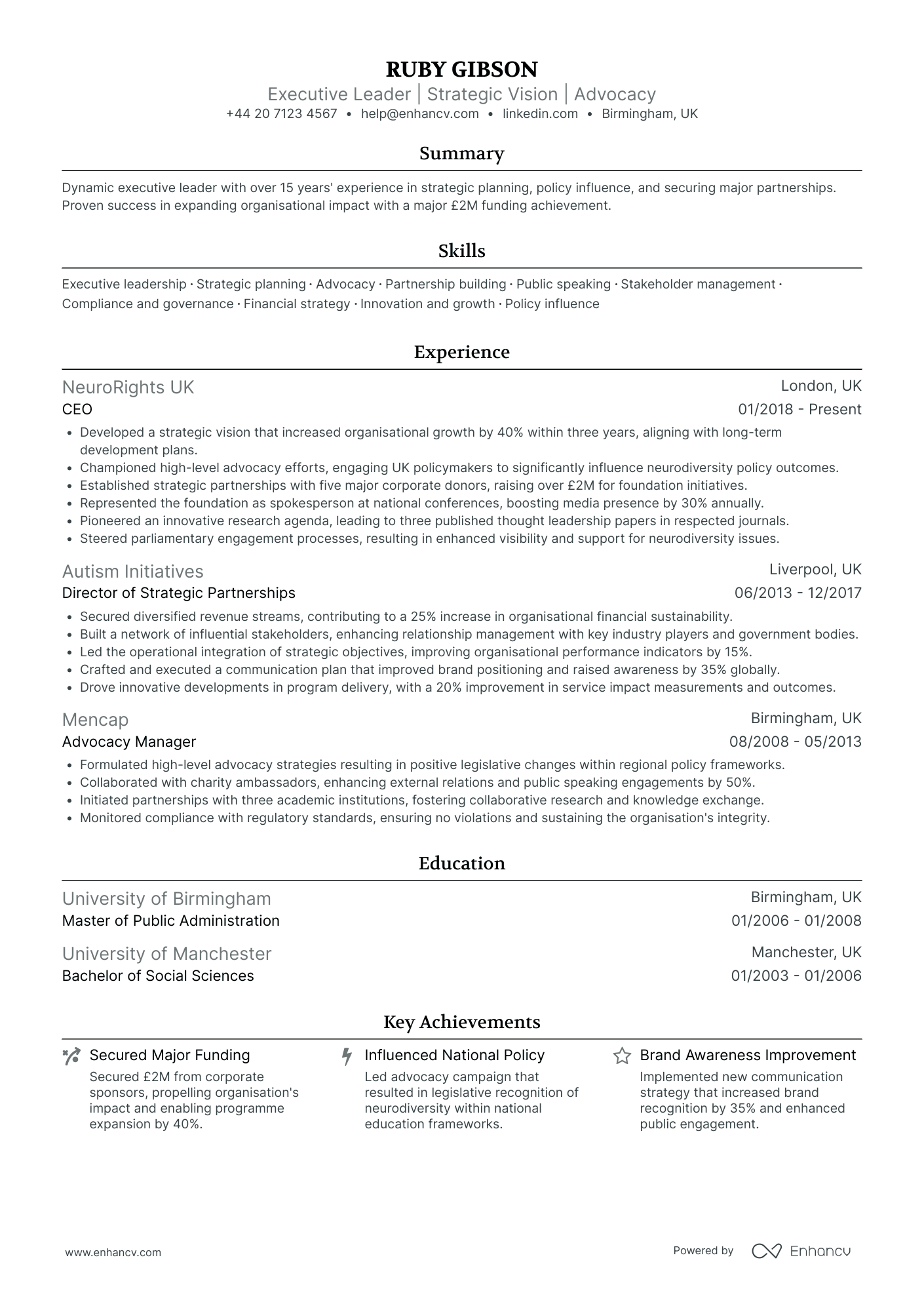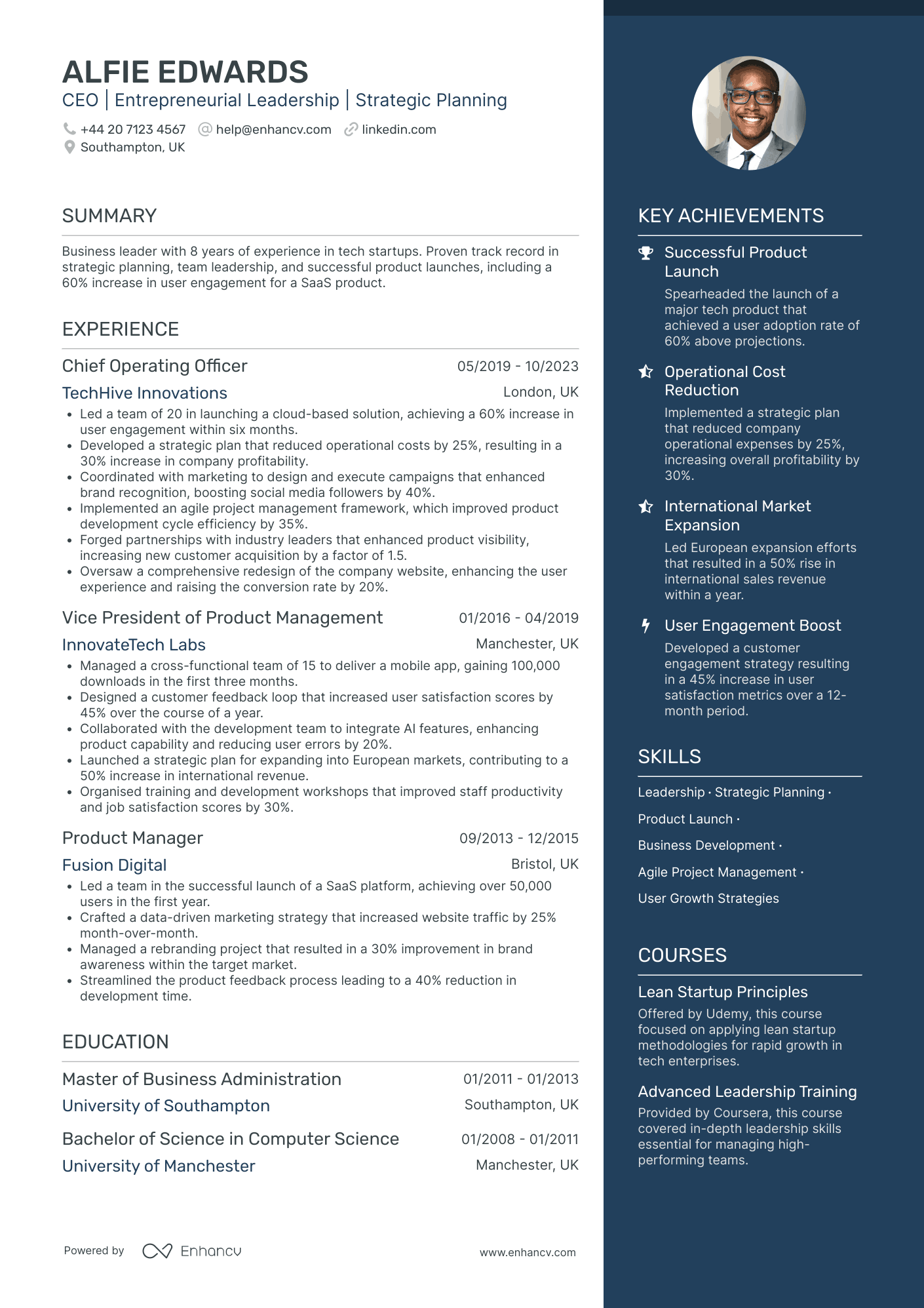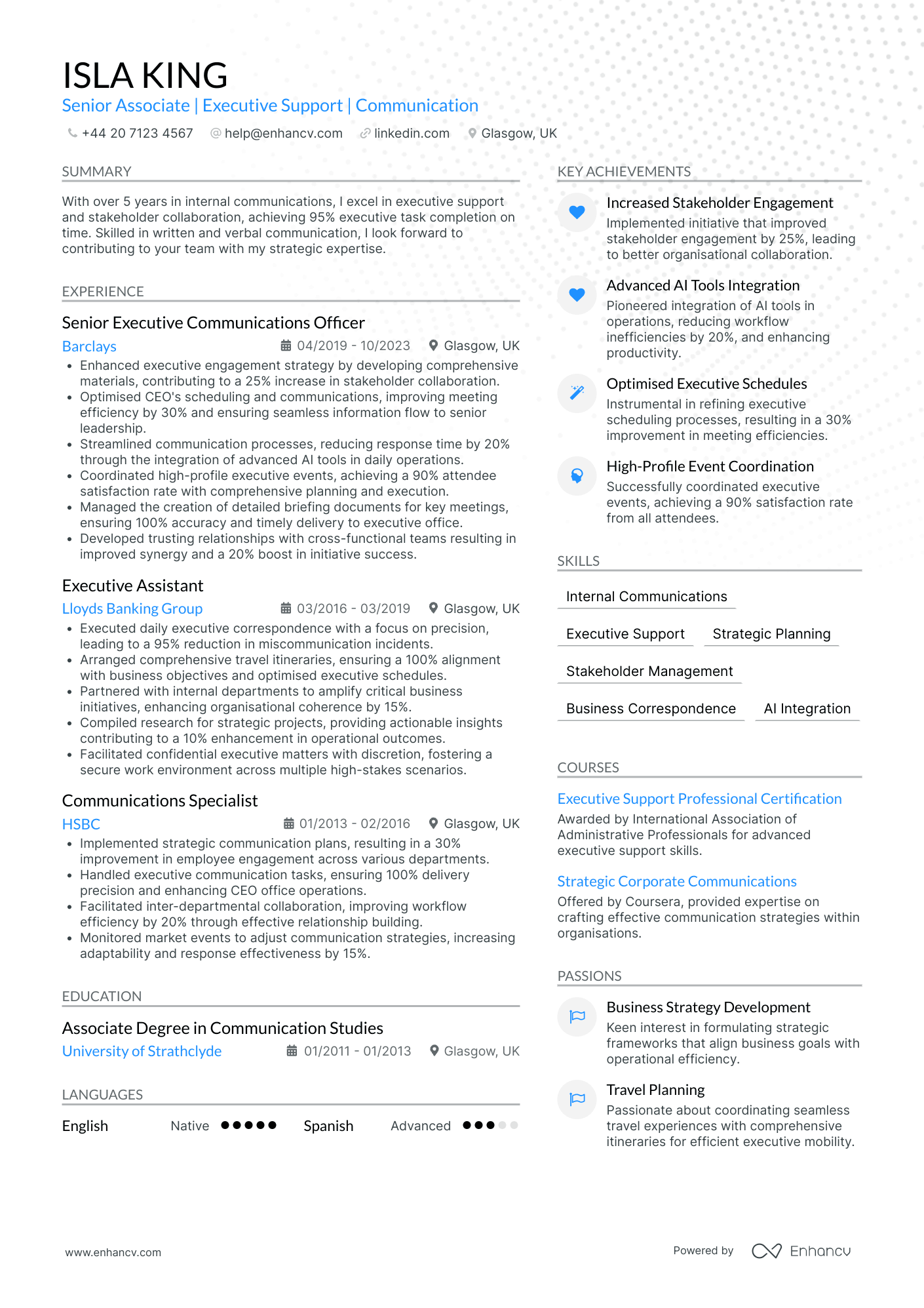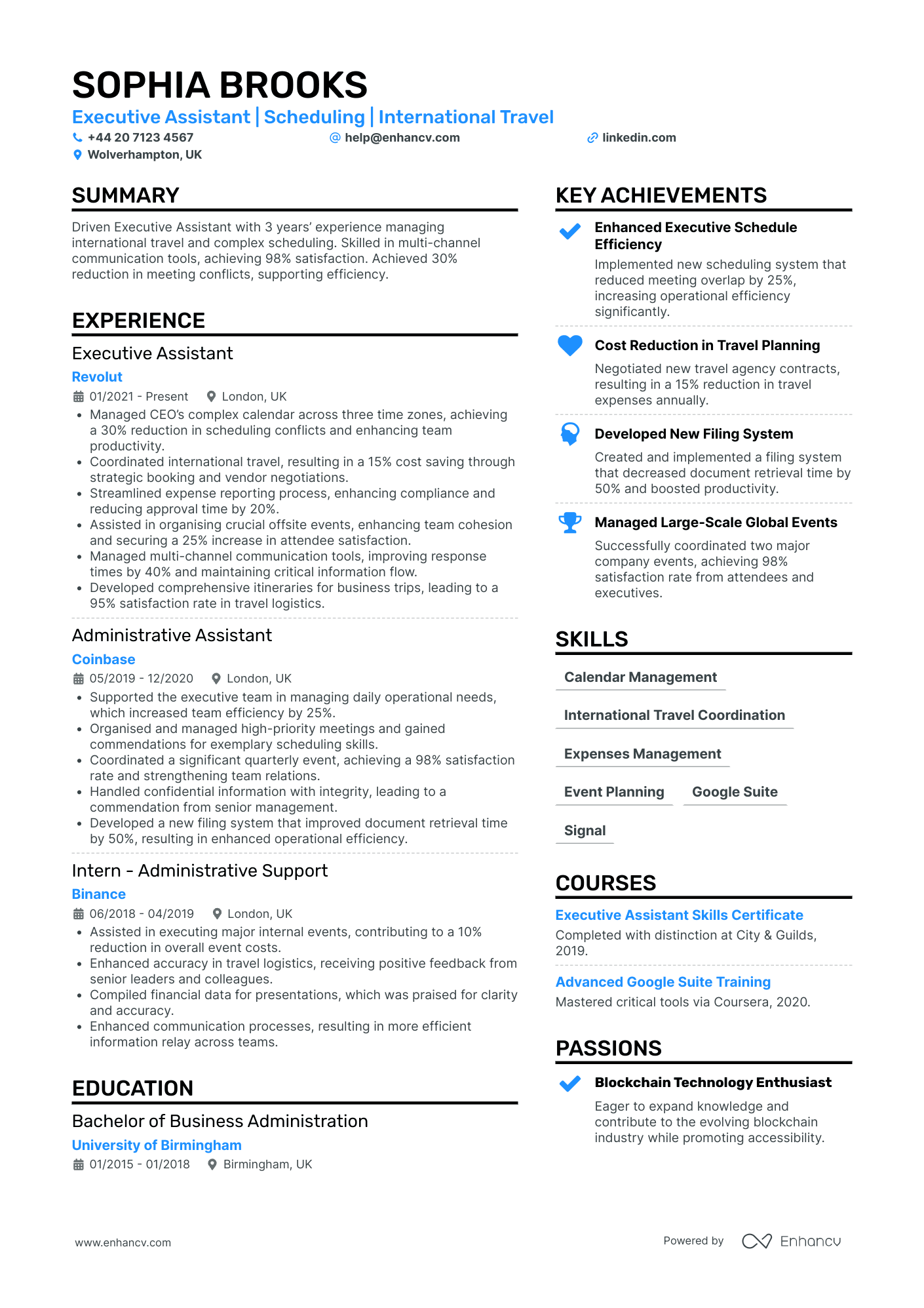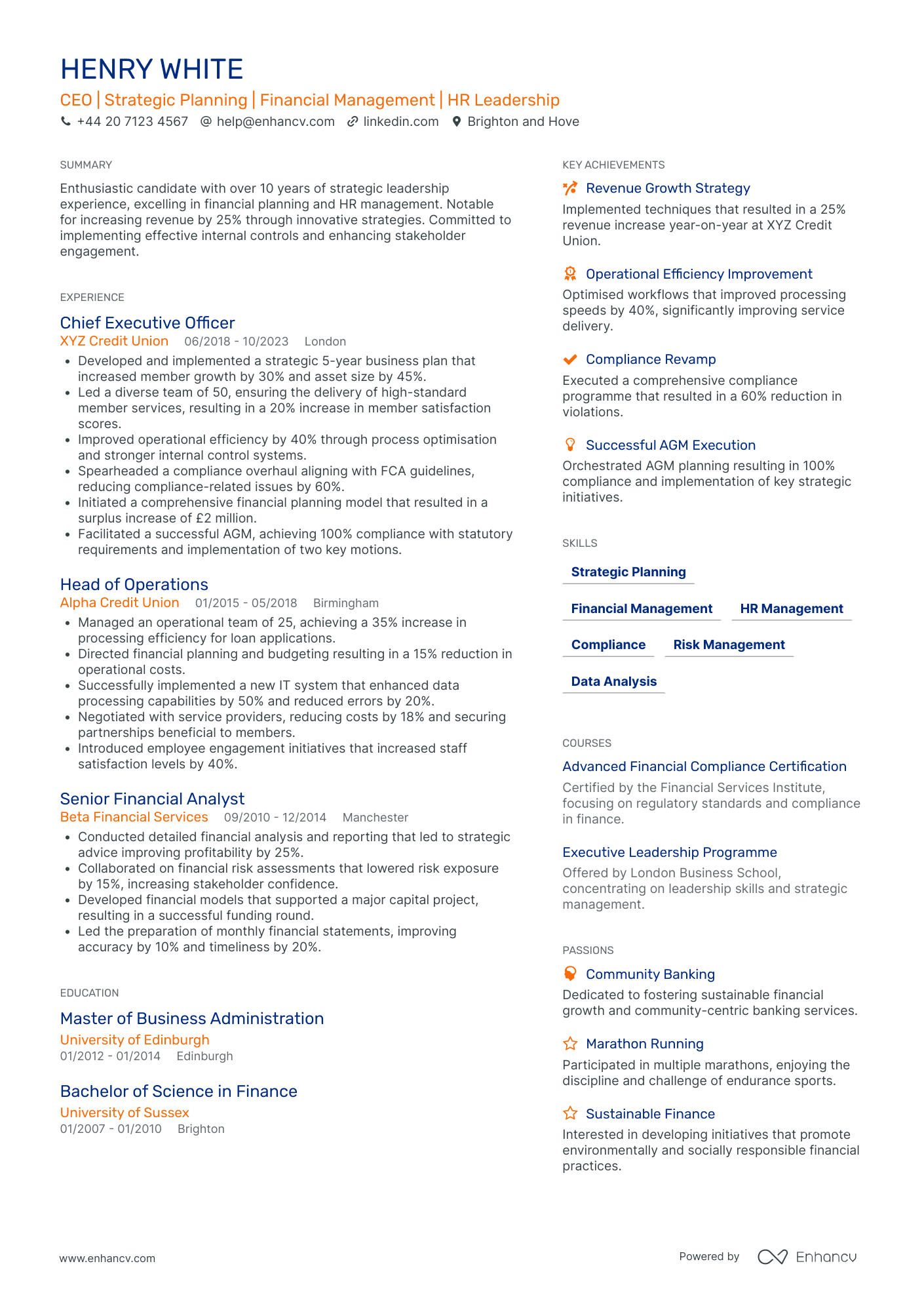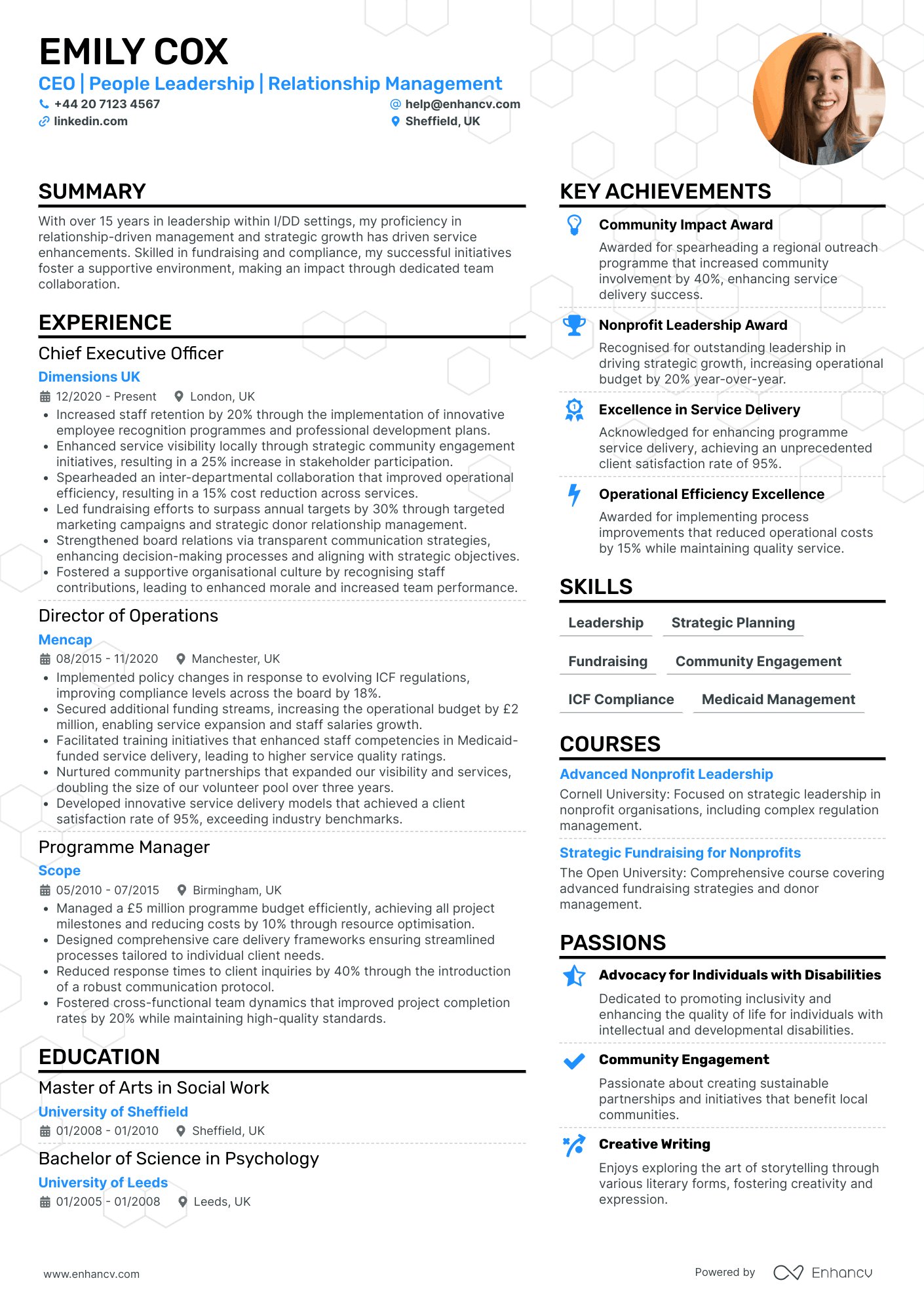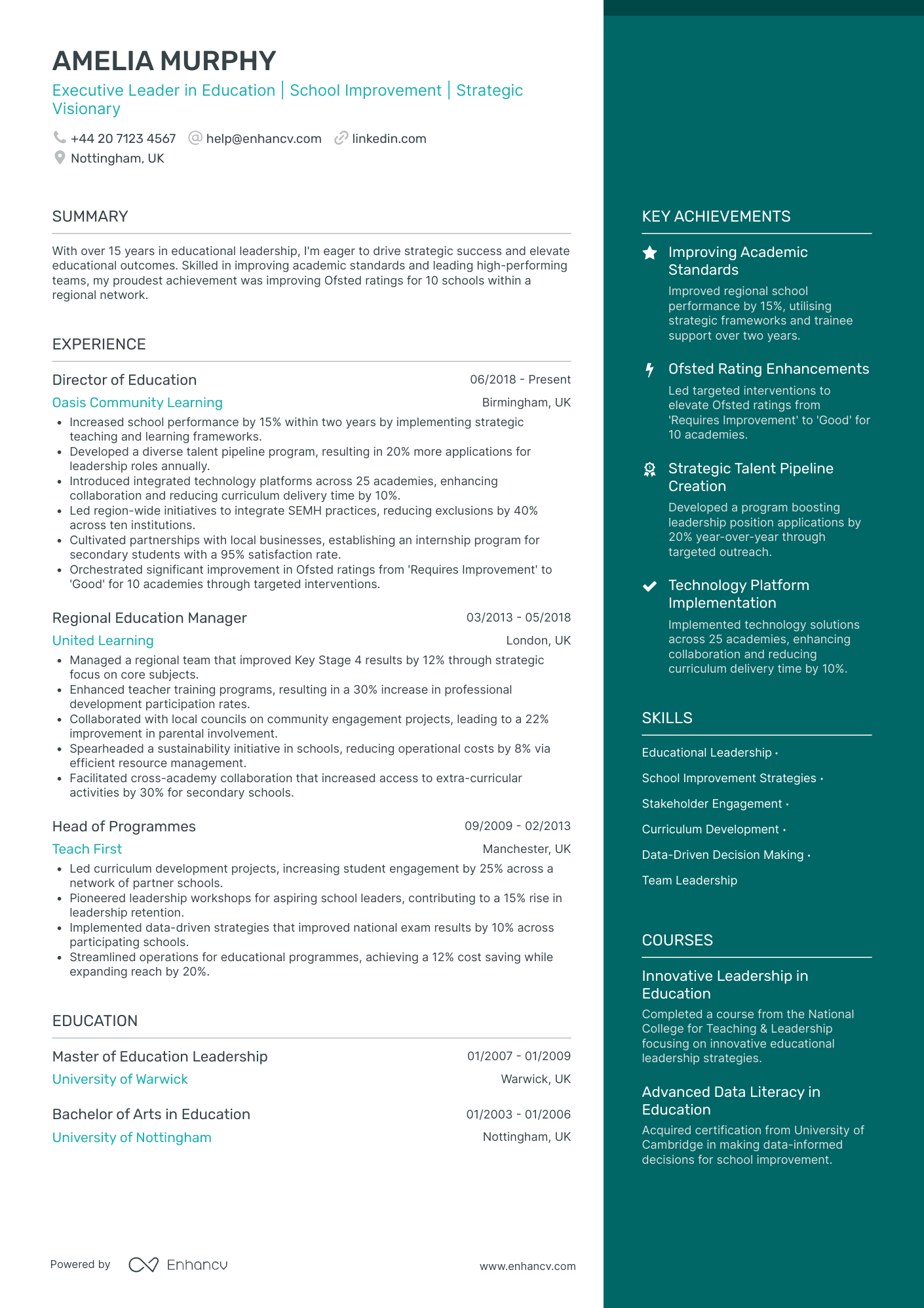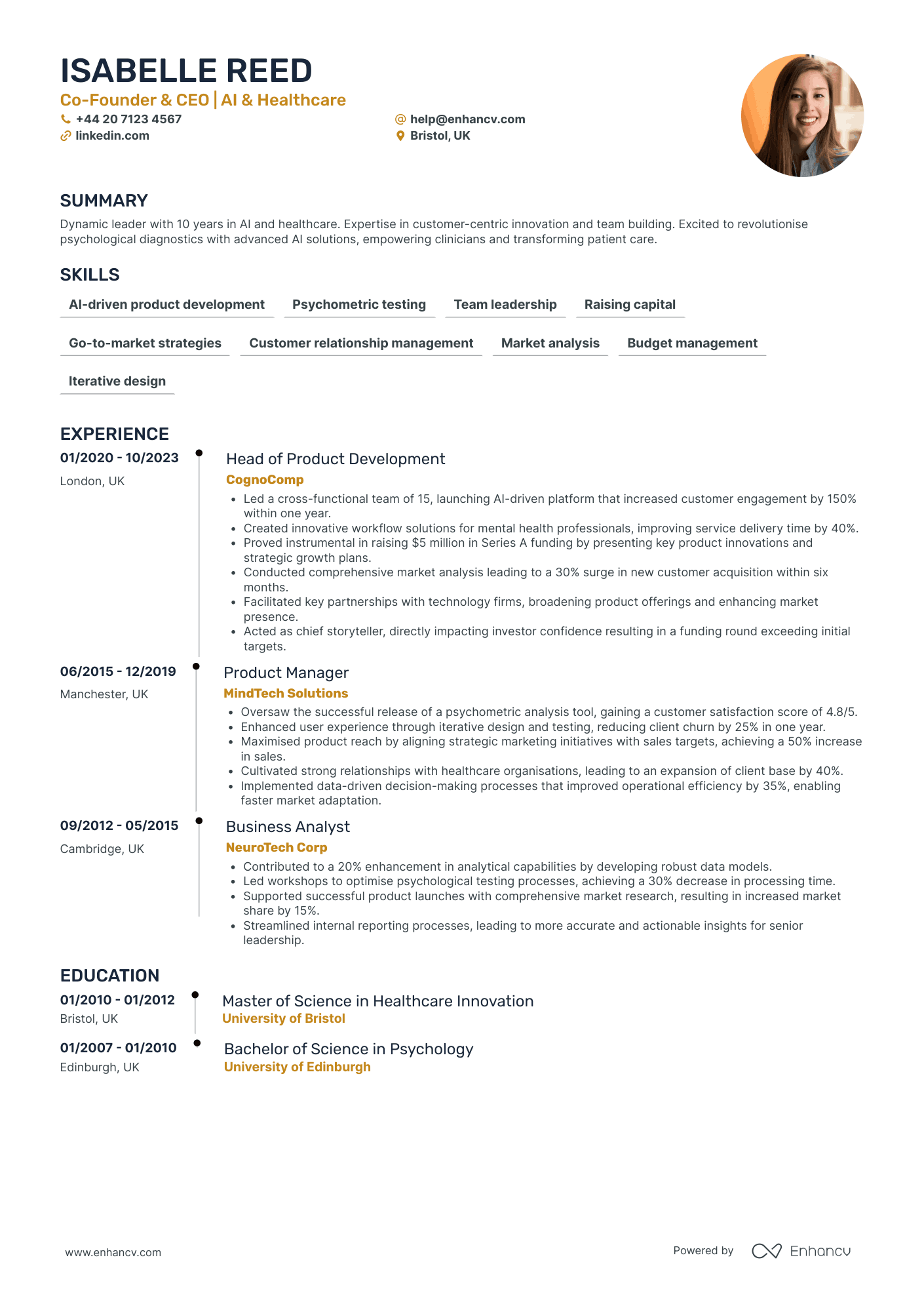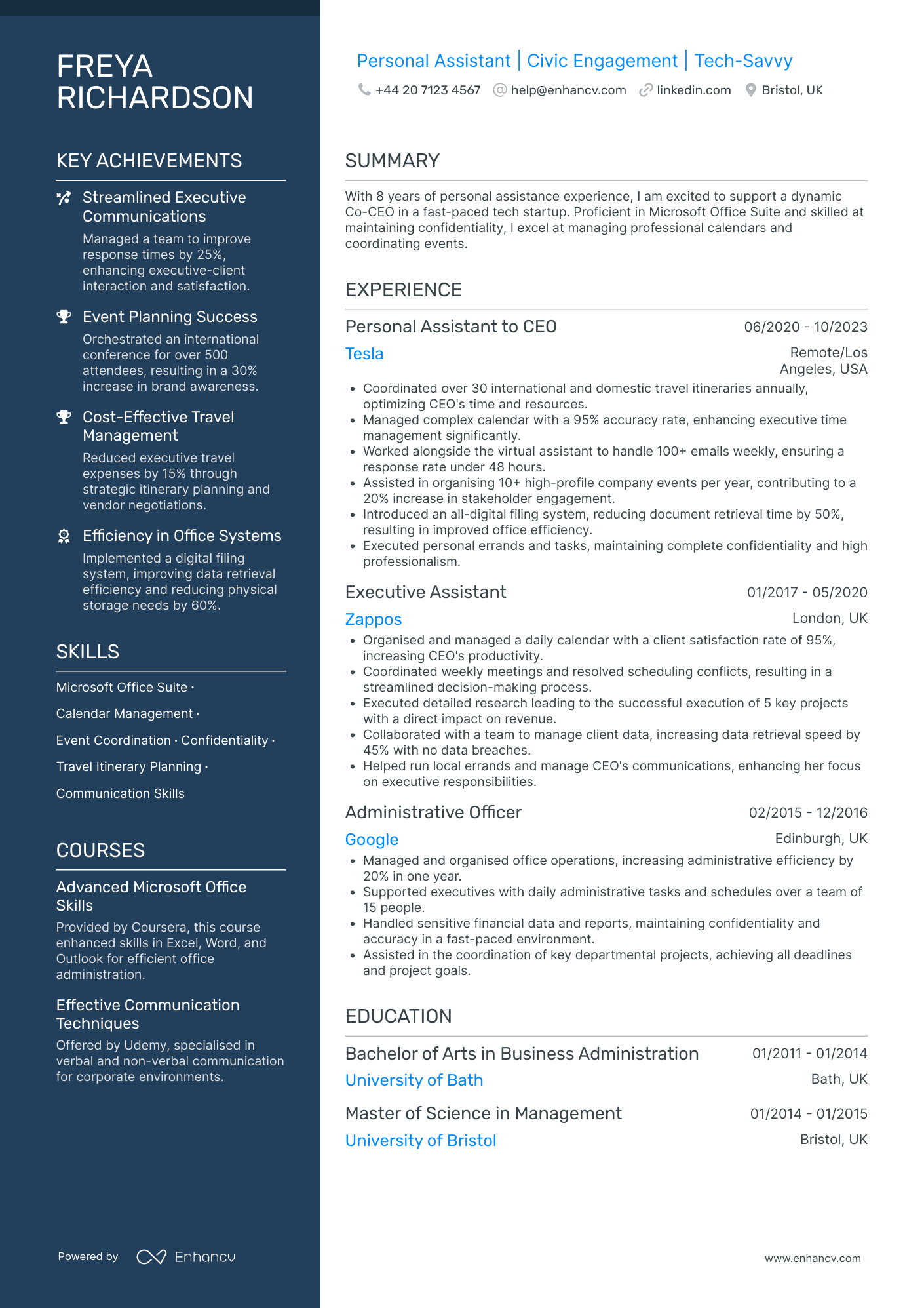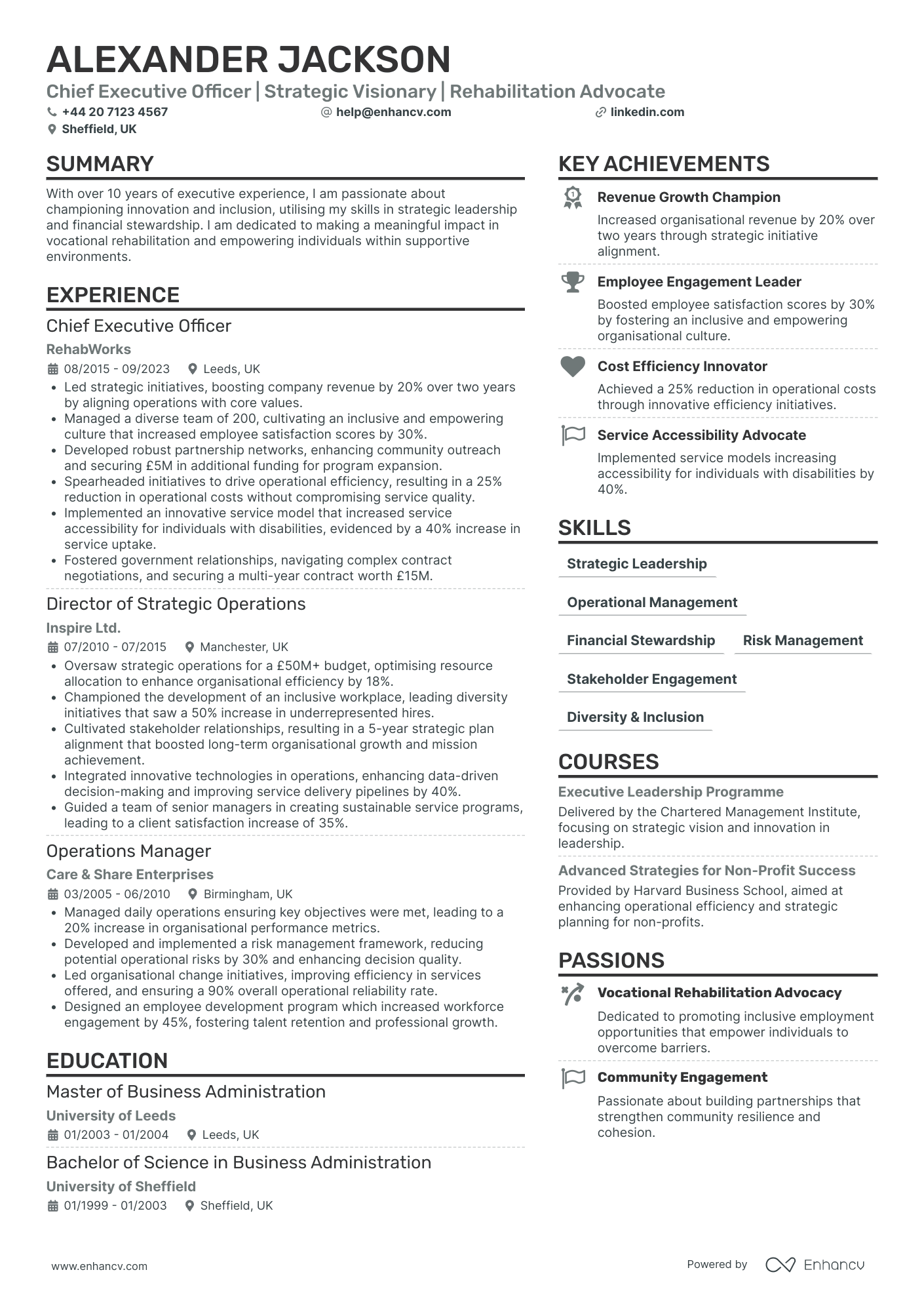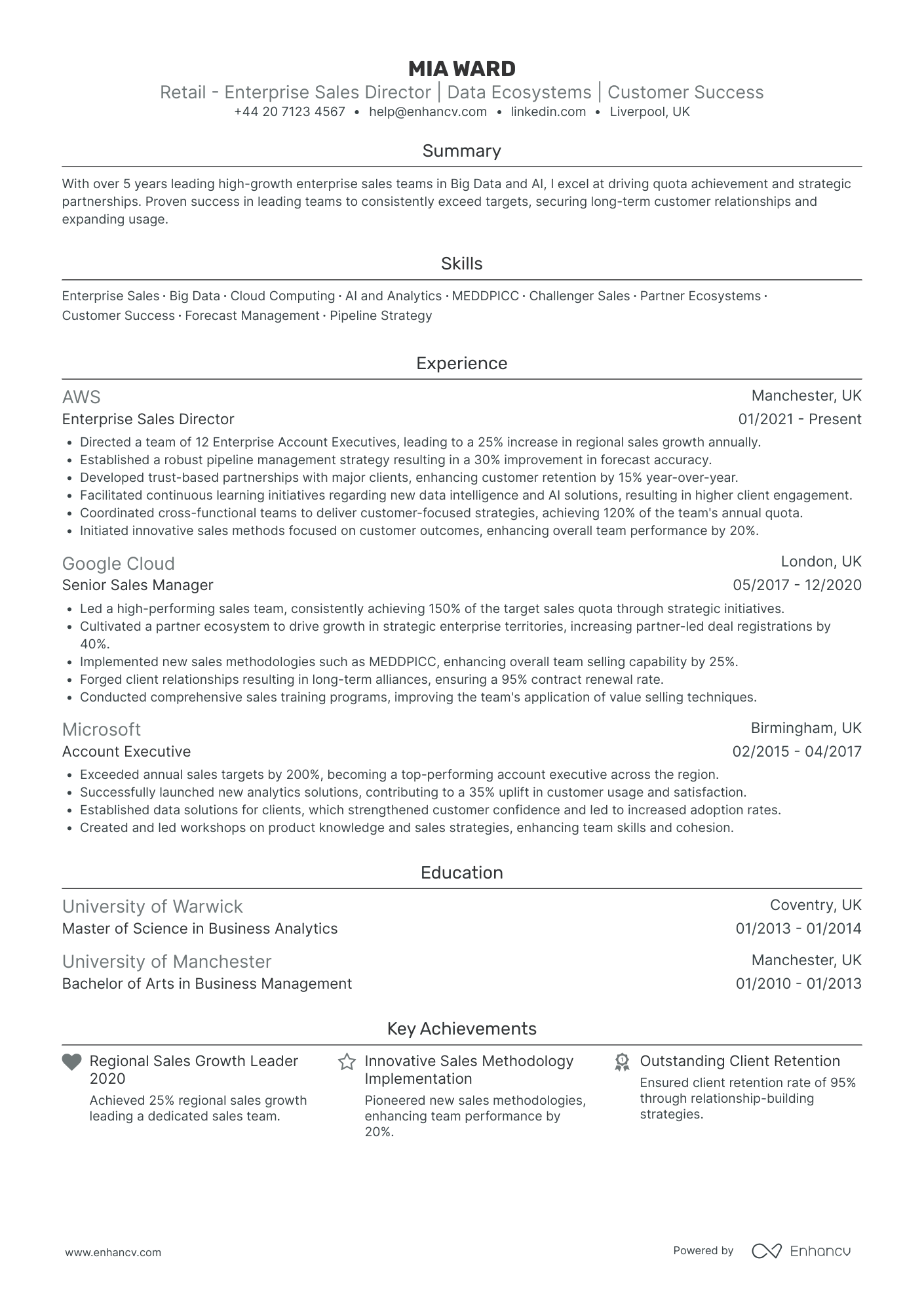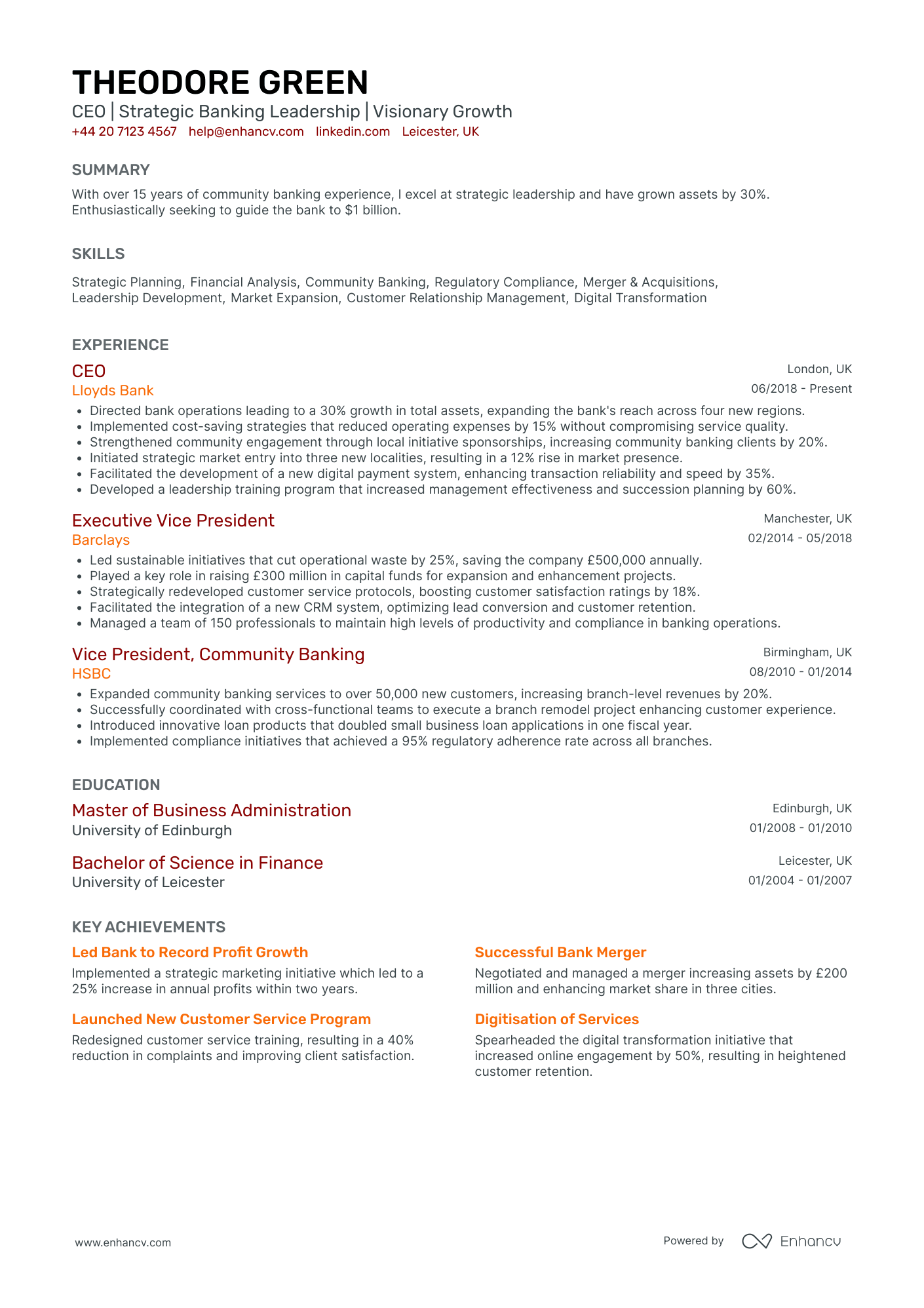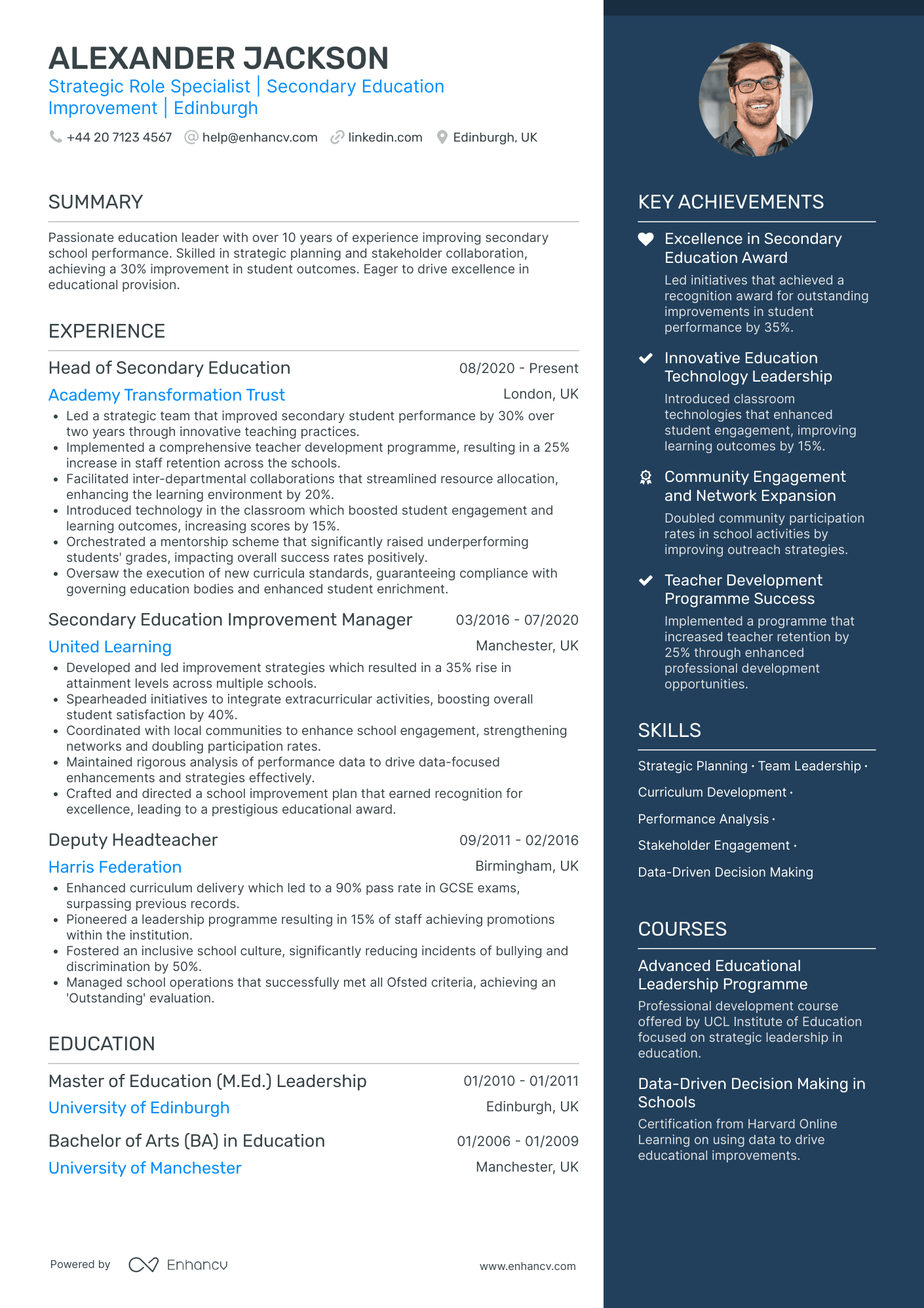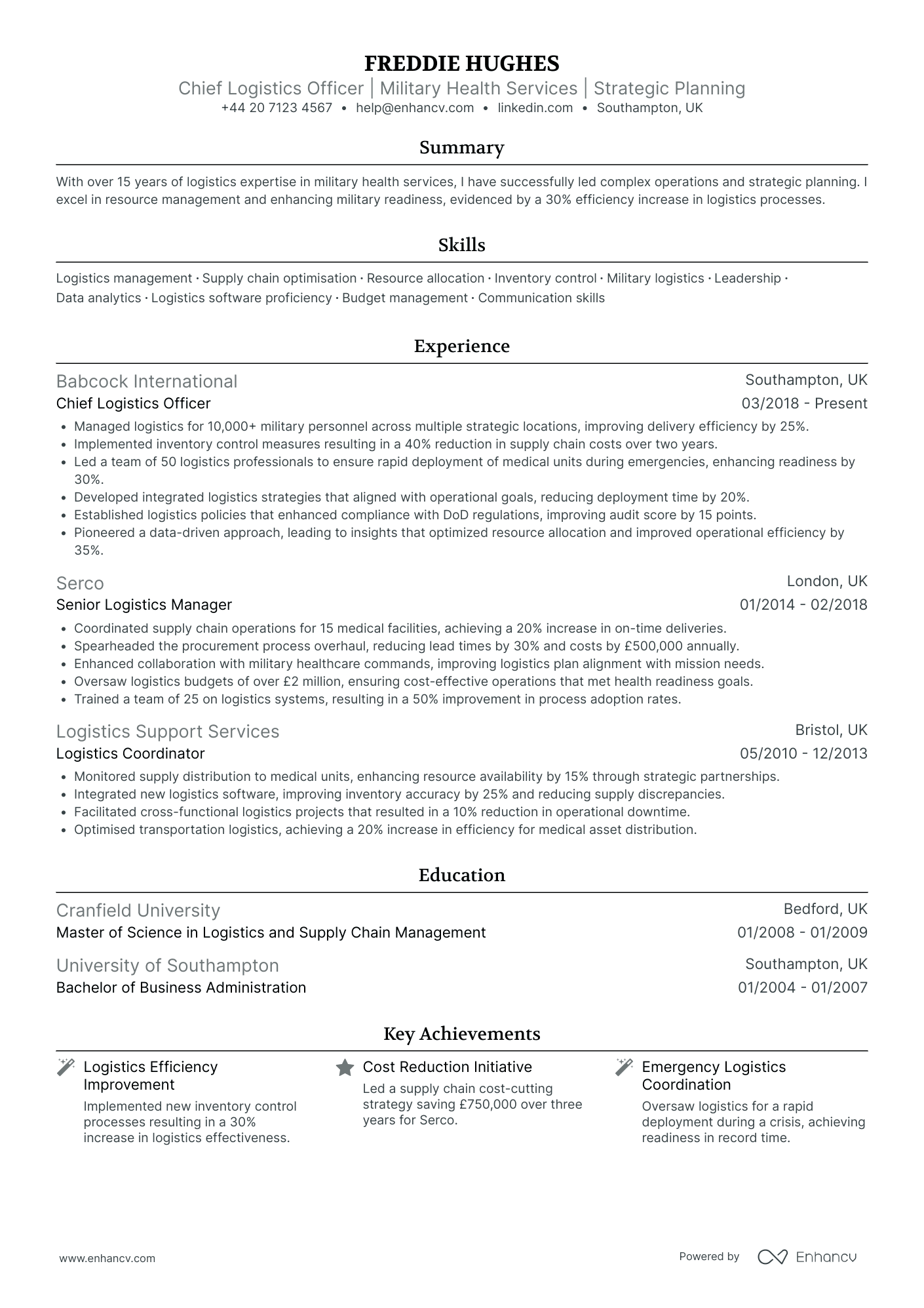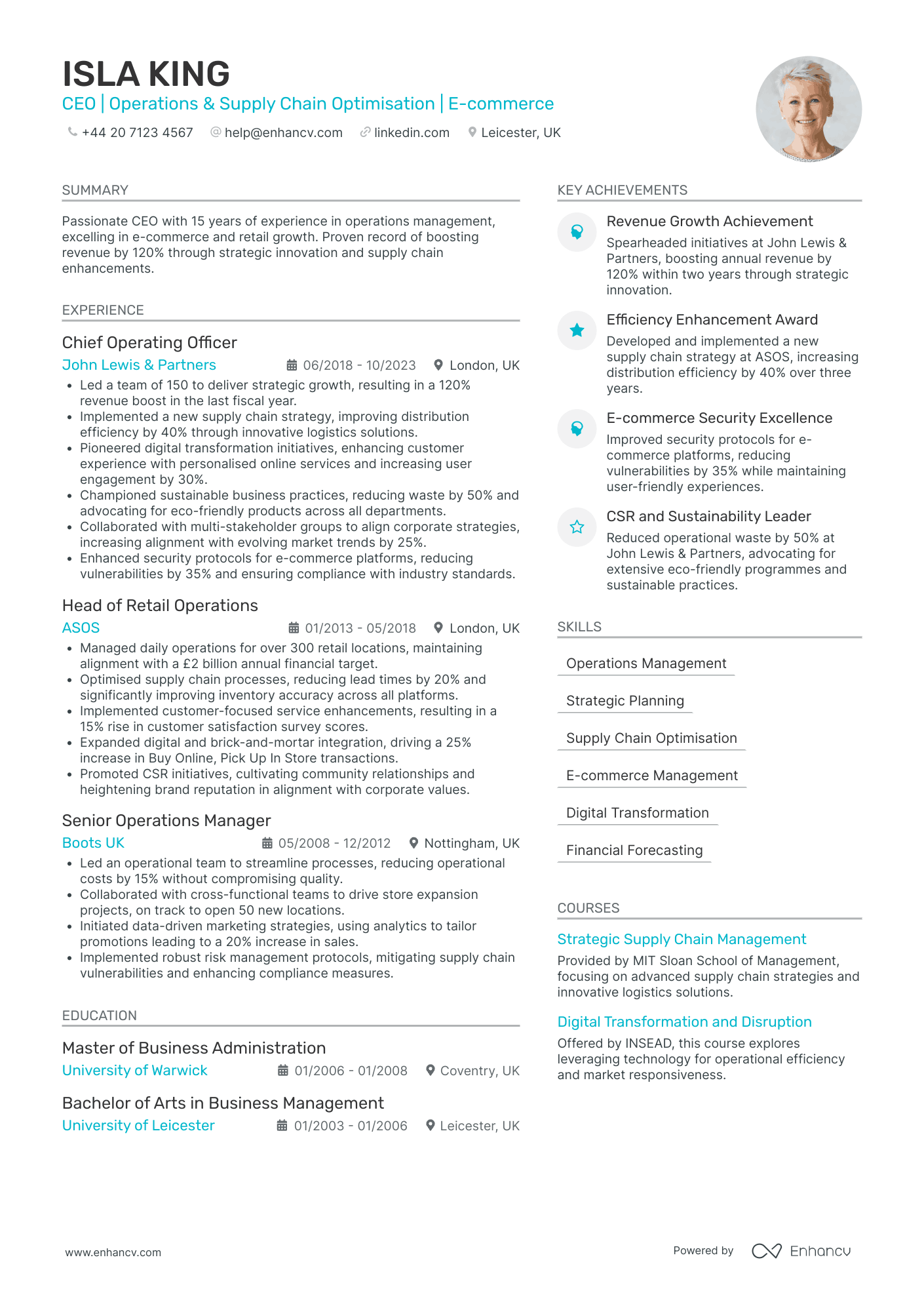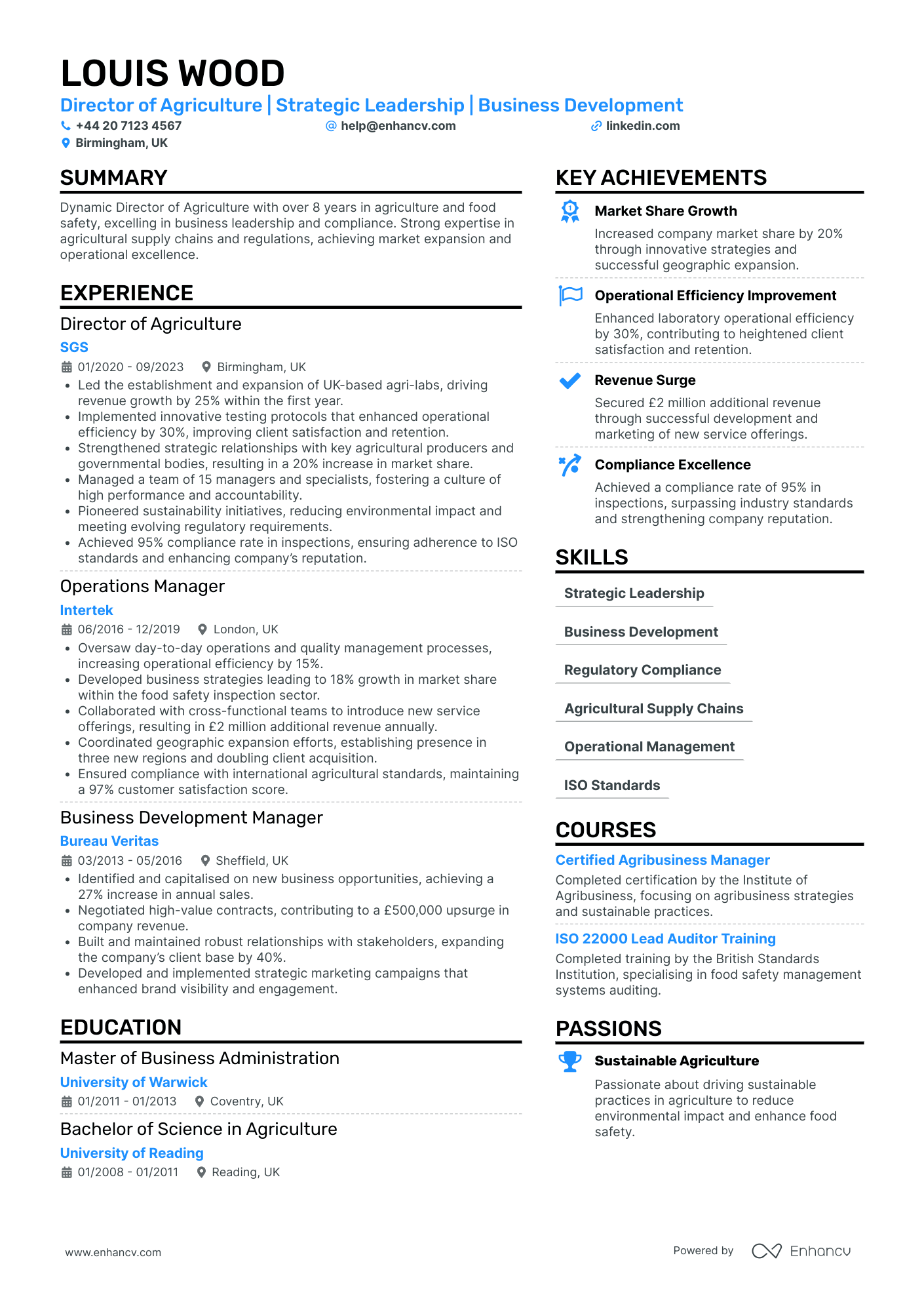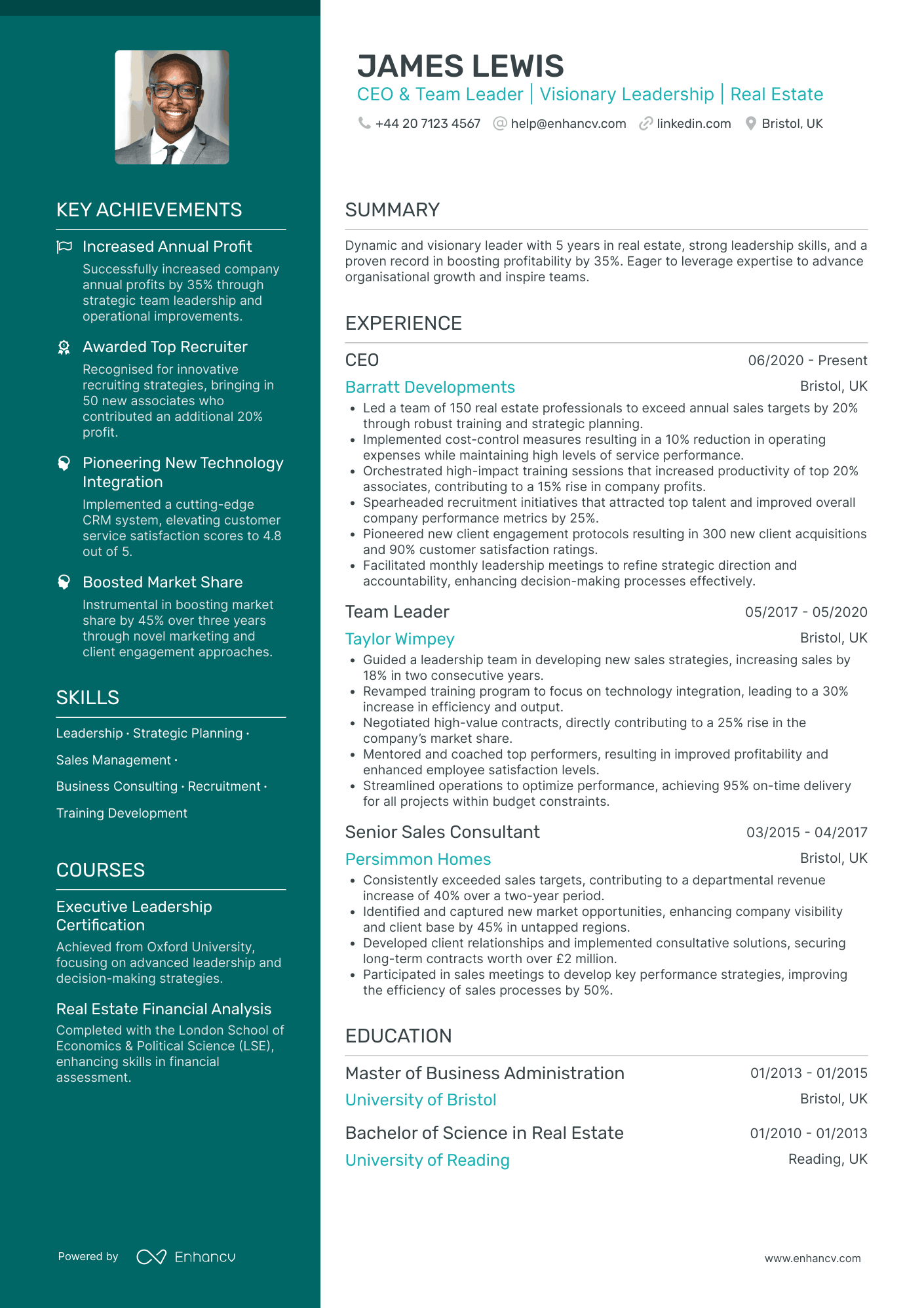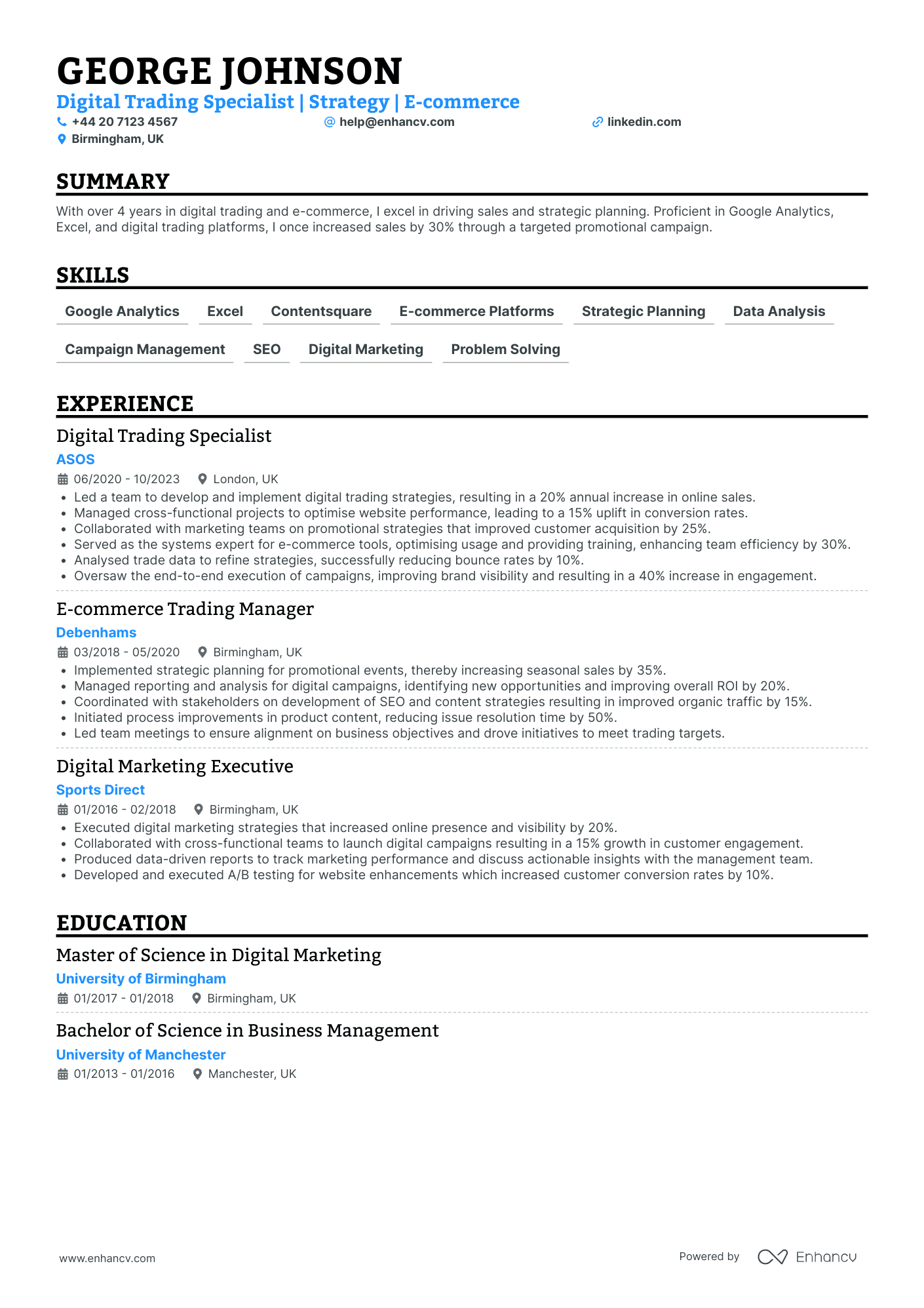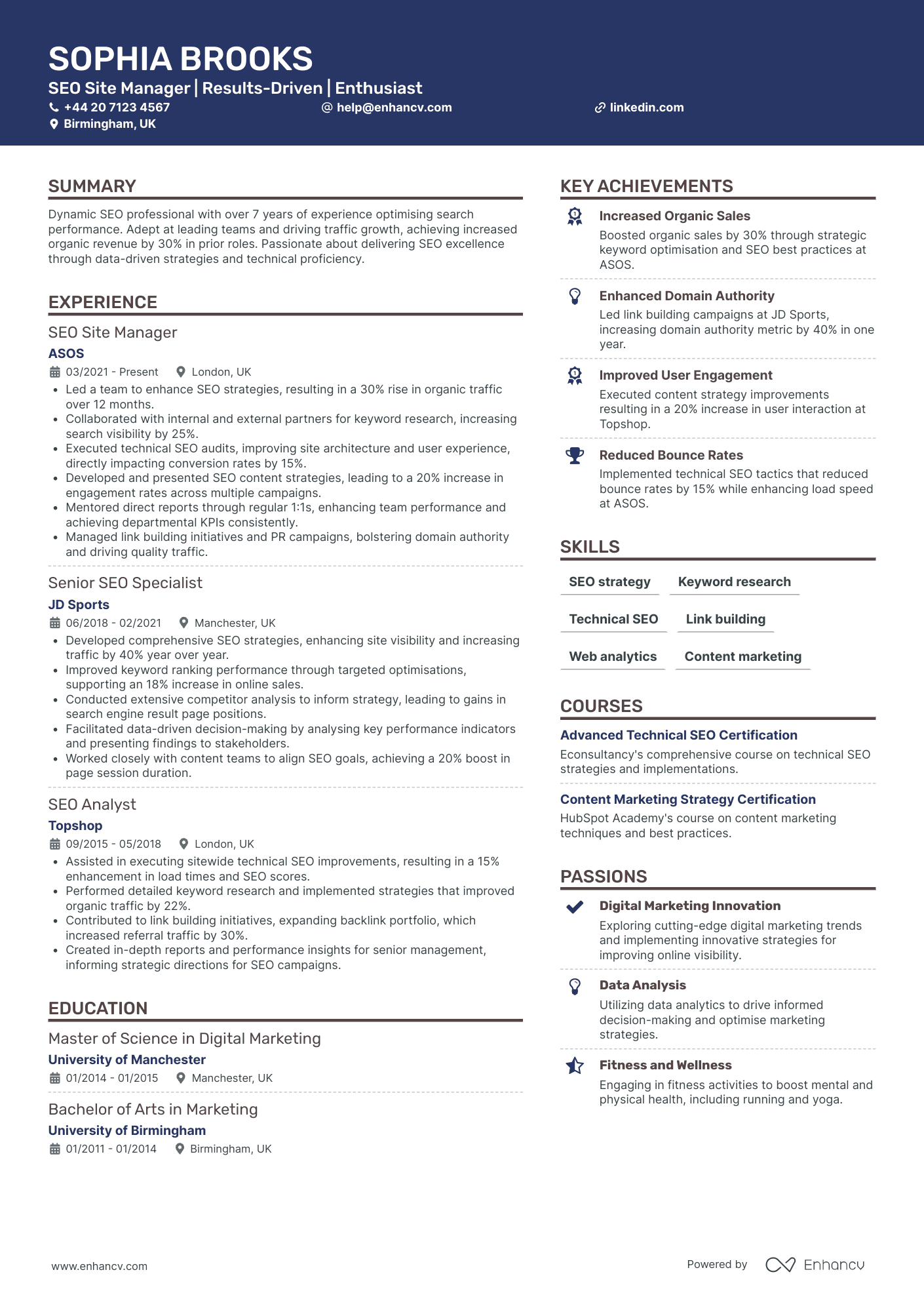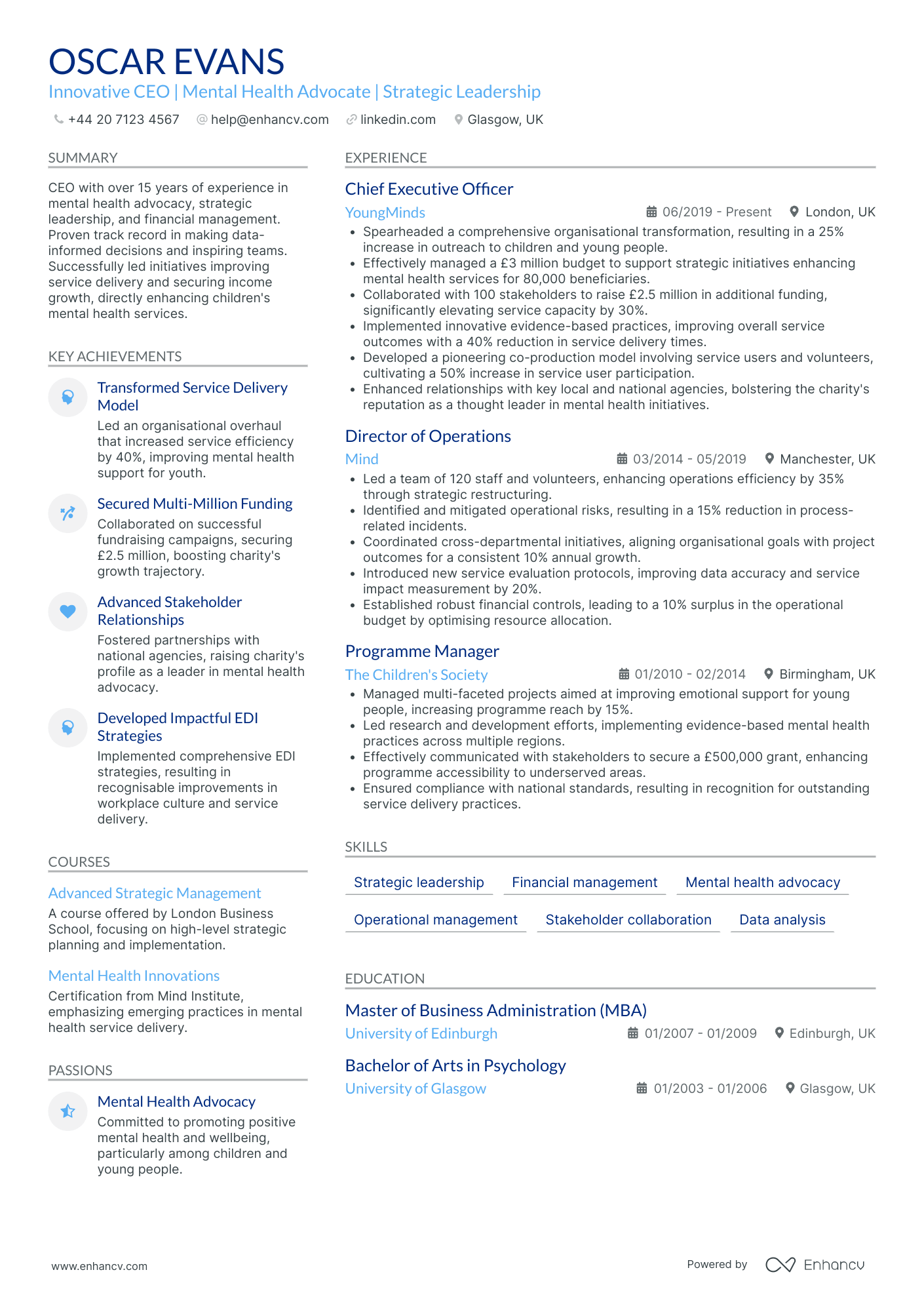Navigating the complexities of articulating your diverse leadership experience and vision for multiple industries can be a significant CV challenge for a CEO like yourself. Our bespoke guide provides strategic insights into refining your narrative, ensuring that your unique skill set and accomplishments are succinctly captured and resonate with the high-calibre organisations you aspire to lead.
- Answer job requirements with your ceo CV and experience;
- Curate your academic background and certificates, following industry-leading CV examples;
- Select from +10 niche skills to match the ideal candidate profile
- Write a more succinct experience section that consists of all the right details.
Do you need more specific insights into writing your ceo CV? Our guides focus on unique insights for each individual role:
Resume examples for ceo
By Experience
Interim CEO
- Clear Structure and Presentation - The CV is well-organized with distinct sections for personal information, professional experience, education, skills, and achievements. Each section is concise and clearly labeled, allowing for easy navigation and quick identification of key information.
- Expansive Career Trajectory - Ruby Gibson's career has shown significant growth, highlighted by her ascension to the role of CEO at NeuroRights UK. Her journey from Advocacy Manager at Mencap to Director of Strategic Partnerships, and then CEO, demonstrates her strong upward mobility and adaptation to increasing levels of responsibility in the advocacy and non-profit sectors.
- Influential Advocacy and Fundraising Achievements - The CV effectively details achievements that have had a meaningful impact on the organizations she’s been part of. For instance, her role in securing £2M in funding highlights her efficacy in partnership building and fundraising, while her successful advocacy efforts have influenced national policy, showcasing her broad impact beyond mere numbers.
Startup CEO
- Structured Career Growth - Alfie Edwards' CV showcases a clear and impressive career trajectory, progressing from a Product Manager to CEO-level roles. Each position aligns with increased responsibilities and complexity, signaling his capability to handle strategic operations and drive company success within the tech industry.
- Cross-Functional Leadership - The CV emphasizes Alfie's ability to lead diverse teams across various functions, from marketing to product development. This versatility highlights his adeptness in coordinating between departments to achieve business goals, showcasing his inclusive leadership style and strategic alignment in decision-making processes.
- Quantifiable Business Achievements - Alfie's accomplishments are accompanied by significant metrics, such as a 60% increase in user engagement and a 50% increase in international revenue. These figures not only demonstrate his capability to drive growth and efficiency but also underscore his strategic aptitude to make substantial business impacts that go beyond mere operational enhancements.
Associate CEO
- Clear and Structured Presentation - The CV is well-organized with distinct sections for each key area such as experience, education, and skills. Each position is accompanied by concise bullet points that effectively communicate the candidate's responsibilities and achievements, ensuring clarity and easy navigation for the reader.
- Consistent Career Growth - The career trajectory demonstrates a steady progression in roles within the financial industry, moving from a Communication Specialist to a Senior Executive Communications Officer. This indicates the candidate's ability to climb the corporate ladder and take on increasing responsibilities over time.
- Integration of Advanced Tools - A notable aspect is the candidate's focus on AI integration, which is highlighted as part of their achievements. This demonstrates their capability to incorporate cutting-edge technology to enhance operational efficiency and productivity, a skill highly valued in today's digital-first business environments.
Junior CEO
- Clarity and Structured Presentation - Sophia Brooks' CV is meticulously structured with clearly defined sections, making it easy to navigate. Her professional summary effectively distills her key skills and achievements, while each subsequent section builds on these, ensuring clarity and seamless flow of information.
- Consistent Career Growth - The CV effectively traces Sophia's advancement from an intern to an executive assistant, indicating a strong trajectory of career development. Each role showcases a step up in responsibility and scope, reflecting both her adaptability and expertise within the industry.
- Unique Industry Tools and Methodologies - Sophia demonstrates a rich proficiency in industry-specific tools like Google Suite, Signal, and Slack, along with advanced methodologies in scheduling and travel coordination. Her ability to optimize communication and management platforms highlights a technical depth that is crucial for her role.
Acting CEO
- Structured and Concise Presentation - The CV is well-organized, starting with a succinct summary that encapsulates the candidate's qualifications in strategic leadership, financial planning, and HR management. Each section is neatly laid out, providing clear and concise bullet points that capture significant achievements and roles, making the information easy to digest for the reader.
- Progressive Career Trajectory - Henry White's career progression from a Senior Financial Analyst to Chief Executive Officer demonstrates significant growth, showcasing his ability to take on increasing responsibilities and leadership roles. This steady advancement reflects both professional skill and the ability to adapt and excel in different environments within the financial services industry.
- Impactful Achievements with Business Relevance - The CV highlights quantifiable achievements that are directly tied to business performance improvements, such as boosting revenues by 25% and enhancing operational efficiency by 40%. These metrics not only underline the candidate's capability to contribute to organizational growth but also underscore a strategic approach to achieving long-term business goals.
By Role
CEO in Healthcare
- Structured Clarity and Conciseness - The CV is impeccably organized, with clearly defined sections that allow for quick navigation through Emily Cox's career history. Each role is succinctly described, with bullet points ensuring concise communication of her key responsibilities and achievements.
- Strategic Career Growth and Leadership Roles - Emily's career trajectory demonstrates a clear progression from Programme Manager to Director of Operations, and finally, to CEO. This illustrates her growth and ability to take on increased responsibility within the I/DD sector, underpinned by her strong leadership capabilities.
- Significant Impact on Business Outcomes and Stakeholder Engagement - Her achievements are not just quantified but also contextualized, demonstrating Emily's ability to enhance service visibility, increase stakeholder engagement, and achieve funding success. These accomplishments showcase her strategic impact in driving organizational success.
Deputy CEO
- Structured and Concise Presentation - The CV is well-organized and easy to navigate, with clear headings and structured sections. Each role is succinctly described with bullet points that highlight key achievements and responsibilities, ensuring that the most important information is accessible and easy to digest.
- Progressive Career Trajectory - Amelia’s career path demonstrates consistent upward mobility and increased responsibility. Beginning as Head of Programmes and advancing to Director of Education, her promotions reflect subject matter expertise in education and a deep understanding of strategic leadership within the academic sector.
- Strategic Achievements with Business Relevance - Each achievement is tied to meaningful outcomes, such as improving Ofsted ratings and enhancing school performance by 15%. These accomplishments not only showcase her impact on educational institutions but also demonstrate her ability to drive substantive improvements that align with the long-term goals of the organizations she works for.
CEO in FinTech
- Clear and Engaging Content Presentation - The CV is skillfully structured, making it easy to navigate and understand. Isabelle Reed provides a clear and succinct overview of her professional journey, with well-organized sections that help in quickly grasping her core competencies and historical contributions.
- Consistent Career Progression and Industry Adaptation - Isabelle has demonstrated significant growth within the healthcare sector, transitioning smoothly from a Business Analyst role to a Co-Founder and CEO. Her career trajectory reflects a strategic move towards AI-focused healthcare solutions, showcasing her ability to pivot and thrive in evolving industries.
- Business-Relevant Achievements - The CV highlights numerous impactful achievements, such as leading a successful AI platform launch that increased engagement by 150% and securing $5 million in Series A funding. These milestones not only reflect her industry acumen but also emphasize her contributions to business expansion and technological advancement.
Co-CEO
- Comprehensive Career Growth - Freya Richardson's CV demonstrates a clear career progression, moving from an Administrative Officer at Google to a Personal Assistant to the CEO of Tesla. This trajectory shows a steady ascent in responsibilities and expertise, reflecting both skill advancement and trust in her abilities.
- Adaptability and Cross-Functional Experience - Freya displays significant adaptability by having worked in diverse settings, including remote roles and various locations, from Edinburgh to Los Angeles. Her experience with tech giants and a customer-centric company like Zappos suggests versatility in adapting to different corporate cultures and industry demands.
- Strong Inclusion of Industry-Specific Tools and Methodologies - The CV highlights Freya's proficiency with Microsoft Office Suite and other technical skills, like introducing a digital filing system that improved efficiency. Her tech-savvy qualities are crucial for adapting to fast-paced and ever-evolving technological environments at top-tier companies.
CEO in Nonprofit
- Structured Presentation and Clarity - The CV is presented in a well-organized manner, making it easy to follow and comprehend. The use of clear headings and bullet points facilitates quick navigation and allows key achievements and responsibilities to stand out, ensuring every detail serves a purpose without overwhelming the reader.
- Significant Career Progression - The candidate’s career trajectory shows a clear path of progression, marked by steady promotions from Operations Manager to Chief Executive Officer. This growth not only highlights leadership capabilities but also demonstrates the versatility in handling diverse operational scales across different organizations within the UK.
- Impactful Achievements with Strategic Value - Achievements are framed in the context of their business impact rather than just numbers, such as leading to an increase in revenue by aligning strategic initiatives or enhancing operational efficiency without reducing service quality. This approach underscores the candidate’s ability to link personal accomplishments with broader organizational goals.
CEO in Retail
- Effective Content Presentation - The CV is well-structured, presenting information in a clear and concise manner that highlights the candidate's career accomplishments. Each section is distinct and easy to navigate, which allows potential employers to quickly grasp the candidate’s qualifications and achievements. By employing bullet points and organized sections, the document maintains an elevated level of clarity and professionalism.
- Diverse Career Trajectory - Mia Ward's career trajectory illustrates steady growth and advancement within the tech industry, moving from an Account Executive at Microsoft to an Enterprise Sales Director at AWS. This progression showcases her ability to adapt and excel in increasingly significant roles, reflecting her leadership, strategic insight, and proficiency in enterprise sales environments.
- Rich Industry-Specific Expertise - The CV incorporates industry-specific methodologies such as MEDDPICC and various data and AI solutions, underscoring Mia's technical depth in sales and her focus on advanced enterprise strategies. These elements not only demonstrate her command over necessary sales tools but also her innovative approach in implementing these to achieve substantial business outcomes.
CEO in Manufacturing
- Structured Educational Background - The CV highlights a strong educational foundation with a Bachelor’s degree in Finance followed by an MBA, both from prestigious universities. This structured academic history supports Theodore's expertise in banking and financial strategies, essential for a CEO's role in strategic leadership and growth.
- Impressive Leadership and Soft Skills - The document showcases Theodore's leadership by detailing successful team management and development initiatives. Specifically, his efforts in leadership training programs and community engagement initiatives demonstrate his effectiveness in leading large teams and fostering strong corporate cultures.
- Cross-Functional Experience with Business Impact - Theodore's career trajectory reveals significant cross-functional experiences, especially through roles requiring coordination across multiple teams. His achievements in digital transformation and strategic market entry exemplify his ability to adapt and drive impactful changes across various aspects of the bank's operations.
CEO in Education
- Clear Progressive Career Trajectory - Alexander Jackson's CV shows a logical and steady career progression, moving from a Deputy Headteacher role to more strategic positions such as Secondary Education Improvement Manager and then Head of Secondary Education. This trajectory illustrates both ambition and the successful acquisition of skills and responsibilities consistent with executive leadership and strategic influence in education.
- Impressive Use of Quantifiable Achievements - The CV excels in highlighting successful outcomes through specific, quantifiable achievements. By mentioning improvements like a 30% rise in student outcomes and a 25% growth in staff retention, Jackson effectively demonstrates the tangible impact of his strategies, underscoring his ability to translate vision into measurable success.
- Diverse Skill Set Relevant to Educational Leadership - This CV encompasses a broad range of skills crucial to educational leadership, such as strategic planning, stakeholder engagement, and data-driven decision-making, alongside technical expertise in educational technology integration. These skills paint a picture of a well-rounded leader capable of transforming educational frameworks and improving both staff and student performance.
CEO in Logistics
- Structured and Clear Presentation - The CV is well-structured, providing a clear timeline of career progression and achievements. Each section is concise, ensuring the content is easy to navigate. Bullet points effectively highlight key accomplishments and responsibilities, making it quick for potential employers to identify the candidate's strengths.
- Strategic Career Growth - Freddie's career shows a clear trajectory of increasing responsibility and leadership, starting as a Logistics Coordinator and rising to Chief Logistics Officer. This path reflects his commitment and ability to excel in military logistics, demonstrating capability to adapt and thrive in high-stakes environments.
- Industry-Specific Acumen - The CV highlights Freddie's mastery of military logistics and strategic planning, which is apparent through his implementation of data-driven approaches and compliance with DoD regulations. His technical depth in logistics and innovative strategies for enhancing military health services set him apart in the industry.
CEO in Hospitality
- Showcases Strategic Influence and Leadership - Isla King's CV clearly highlights her ability to lead large teams and drive significant growth. As the CEO with a strategic mindset, she has successfully led teams to deliver impressive revenue boosts and transform supply chains. Her leadership at John Lewis & Partners and ASOS involved not just overseeing operations, but actively engaging in innovative strategy formulation and execution, indicating a strong leadership presence.
- Comprehensive Career Progression - The career trajectory demonstrated in the CV reflects robust growth and advancement aligned with industry trends. Isla King has navigated through various pivotal roles from Senior Operations Manager at Boots UK to CEO with a focus on operations and supply chain optimization. This progression underscores her adaptability and the continuous enhancement of relevant skills, particularly within the e-commerce and retail sectors.
- Integrates Innovative and Sustainable Practices - The CV accentuates Isla’s commitment to sustainable and innovative practices by detailing her initiatives in digital transformation and eco-friendly business approaches. Her efforts in minimizing waste and advocating for sustainability alongside improving digital infrastructure not only align with modern business priorities but also resonate well with increasingly environmentally-conscious consumers.
CEO in Agriculture
- Strategic Clarity and Structure - The CV is structured with clarity, presenting information concisely and logically. Each section flows seamlessly into the next, from personal information to a detailed experience account. The use of bullet points enhances readability, allowing quick identification of key responsibilities and achievements.
- Impressive Career Progression - Louis Wood’s career trajectory demonstrates significant growth and progression within the agriculture industry. He moved from a Business Development Manager role to becoming an Operations Manager, and ultimately, a Director of Agriculture. This progression underscores his capability to take on increasing responsibilities and leadership roles.
- Strong Leadership and Stakeholder Engagement - The CV highlights Wood’s strong leadership skills and ability to foster strategic relationships. He effectively managed teams and strengthened relationships with key stakeholders, indicating his prowess in stakeholder management and high-performance culture cultivation, vital for his leadership roles.
CEO in Real Estate
- Strategic Leadership and Real Estate Vision - The CV effectively outlines James Lewis’s leadership skills and vision, particularly in the real estate context. It presents a clear career path that demonstrates strong leadership, strategic thinking, and an ability to drive company growth and profitability, aligning perfectly with high-level executive roles in real estate or allied sectors.
- Structured and Impactful Presentation - The CV is well-organized, highlighting key sections such as experience, education, skills, and achievements. Each section is clear and concise, offering bullet points that succinctly present key information. This structure helps to immediately convey the candidate’s core competencies and career highlights, making it easy for readers to identify his qualifications for leadership roles.
- Comprehensive Skills and Cross-functional Expertise - By showcasing a blend of skills ranging from strategic planning, sales management, and recruitment, to training, financial oversight, and problem-solving, the CV underscores a holistic view of Lewis’s professional abilities. This cross-functional expertise is crucial in a CEO role, demonstrating adaptability and a comprehensive understanding of business operations within the real estate industry.
CEO in Entertainment
- Clear Organization and Structure - The CV is well-structured, presenting information in a clear and concise manner. Each section is distinctly separated, making it easy to follow the candidate's career progression and relevant skills. The use of bullet points for experience ensures that key achievements and responsibilities are quickly identifiable.
- Impressive Career Growth in Digital Trading - The trajectory of George Johnson's career reflects consistent advancement within the e-commerce industry. Moving from a Digital Marketing Executive to a Digital Trading Specialist, the CV outlines a natural progression through roles that increasingly demand strategic oversight and team leadership.
- Proficiency in Industry-Specific Tools - The document highlights George's adeptness with critical e-commerce and digital analytics tools such as Google Analytics and Contentsquare. This technical depth, combined with certifications in Advanced Google Analytics and E-commerce Strategy, underscores their capability to apply data-driven insights to enhance business performance.
CEO in Construction
- Strong focus on leadership and team development - The CV highlights the candidate's leadership skills by detailing their mentorship of direct reports, managing of link-building initiatives, and collaboration with internal and external partners. This indicates an ability to inspire and guide a team towards achieving key objectives, a crucial attribute for the role of an SEO Site Manager.
- Demonstrates adaptability through varied industry experience - The candidate showcases their ability to adjust to different environments through experience across several companies within the fashion retail sector, including ASOS, JD Sports, and Topshop. This variety suggests an ability to be versatile and apply SEO strategies to diverse company needs and challenges, indicating high adaptability.
- Highlights achievements with clear business impact - The CV effectively illustrates the candidate's success with concrete examples of how their work impacted business outcomes, such as a 30% increase in organic traffic and a 20% rise in engagement rates. These accomplishments reinforce their competency in driving measurable business growth through strategic SEO implementations.
CEO in Energy
- Structured and Concise Presentation - The CV is well-organized, clearly outlining each section with concise details that make it easy to follow. Each element, from the summary to experience and education, is presented in a straightforward manner that succinctly conveys the candidate's qualifications and professional journey.
- Strategic Career Progression - The candidate demonstrates a strategic career trajectory marked by roles with increasing responsibility and impact, such as advancing from Program Manager to CEO. This progression illustrates a deepening expertise in mental health advocacy and strategic leadership, emphasizing growth within the non-profit sector.
- Emphasis on Unique Mental Health Advocacy Initiatives - The CV highlights unique methodologies in mental health services, including evidence-based practices and a pioneering co-production model, indicating a dedication to innovation in enhancing mental health support. This specialization sets them apart in the industry and underscores their influential role in mental health initiatives.
How complex should the format of your ceo CV be?
Perhaps, you decided to use a fancy font and plenty of colours to ensure your ceo CV stands out amongst the pile of other candidate profiles. Alas - this may confuse recruiters. By keeping your format simple and organising your information coherently, you'll ultimately make a better impression. What matters most is your experience, while your CV format should act as complementary thing by:
- Presenting the information in a reverse chronological order with the most recent of your jobs first. This is done so that your career history stays organised and is aligned to the role;
- Making it easy for recruiters to get in touch with you by including your contact details in the CV header. Regarding the design of your CV header, include plenty of white space and icons to draw attention to your information. If you're applying for roles in the UK, don't include a photo, as this is considered a bad practice;
- Organising your most important CV sections with consistent colours, plenty of white space, and appropriate margins (2.54 cm). Remember that your CV design should always aim at legibility and to spotlight your key information;
- Writing no more than two pages of your relevant experience. For candidates who are just starting out in the field, we recommend to have an one-page CV.
One more thing about your CV format - you may be worried if your double column CV is Applicant Tracker System (ATS) complaint. In our recent study, we discovered that both single and double-column CVs are ATS-friendly . Most ATSes out there can also read all serif and sans serif fonts. We suggest you go with modern, yet simple, fonts (e.g. Rubik, Lato, Raleway) instead of the classic Times New Roman. You'll want your application to stand out, and many candidates still go for the classics. Finally, you'll have to export your CV. If you're wondering if you should select Doc or PDF, we always advise going with PDF. Your CV in PDF will stay intact and opens easily on every OS, including Mac OS.
PRO TIP
Incorporate a touch of colour in headers or section breaks, but keep it professional and ensure it doesn’t detract from readability, especially in more conservative industries.
The top sections on a ceo CV
- Executive Profile captures a CEO's essence, summarising leadership philosophy and vision.
- Operational Achievements showcase a CEO's track record of tangible business successes.
- Leadership & Management Experience provides insight into years of leading teams and companies.
- Key Professional Milestones detail significant moments and turning points in a CEO's career.
- Strategic Vision & Planning underscores a CEO's ability to set and achieve long-term goals.
What recruiters value on your CV:
- Emphasise strategic leadership by showcasing your experience in guiding companies through transformation, growth, and market challenges, specifically highlighting successful outcomes.
- Detail your financial acumen by providing concrete examples of how you have driven profitability, managed budgets, and made strategic investment decisions.
- Demonstrate your vision by explaining how you have developed and executed long-term strategies that have positioned organisations for sustainable success.
- Highlight your ability to build and lead high-performance teams, including examples of talent acquisition, development, and establishing a strong company culture.
- Include successful stakeholder management by detailing your experience in engaging with boards, investors, and important partners to align on business objectives.
Recommended reads:
How to present your contact details and job keywords in your ceo CV header
Located at the top of your ceo CV, the header presents recruiters with your key personal information, headline, and professional photo. When creating your CV header, include your:
- Contact details - avoid listing your work email or telephone number and, also, email addresses that sound unprofessional (e.g. koolKittyCat$3@gmail.com is definitely a big no);
- Headline - it should be relevant, concise, and specific to the role you're applying for, integrating keywords and action verbs;
- Photo - instead of including a photograph from your family reunion, select one that shows you in a more professional light. It's also good to note that in some countries (e.g. the UK and US), it's best to avoid photos on your CV as they may serve as bias.
What do other industry professionals include in their CV header? Make sure to check out the next bit of your guide to see real-life examples:
Examples of good CV headlines for ceo:
Chief Executive Officer | Strategic Growth Expert | MBA | 20+ Years Leadership in Tech Industry
Visionary CEO | Keynote Speaker | M&A Specialist | 15 Years Exec-Level Financial Services Leadership
Global CEO | Champion of Sustainability | Harvard Alumni | 25-Year Tenure in Manufacturing & Supply Chain
Seasoned Chief Executive | Healthcare Innovator | PhD in Biotech | 18 Years Driving Medical Advances
Entrepreneurial CEO | AI and Machine Learning Pioneer | BSc, MSc | 12 Years at the Forefront of IT
Dynamic CEO | Retail Industry Leader | Brand Expansion Strategist | 22+ Years of Commercial Success
Catching recruiters' attention with your ceo CV summary or objective
Located closer to the top of your CV, both the summary and objective are no more than five sentences long and serve as an introduction to your experience. What is more, you could use either to entice recruiters to read on. Select the:
- Summary, if you happen to have plenty of relevant experience. Feature your most impressive accomplishments and up to three skills that are relevant to the job you're applying for;
- Objective, if you're just starting your career off. Provide your career goals and answer how you see the role you are applying for will match your professional growth.
Judging which one you need to add to your ceo CV may at times seem difficult. That’s why you need to check out how professionals, with similar to your experience, have written their summary or objective, in the examples below:
CV summaries for a ceo job:
- With 15+ years of experience as a CEO in the technology sector, I have spearheaded the growth of a multimillion-dollar software firm, delivering a 300% increase in market share through strategic acquisitions and cutting-edge product development. An expert in scaling SaaS platforms and leading cross-functional teams.
- A seasoned executive with over two decades in the pharmaceutical industry, I have successfully driven a biotech start-up to become a market leader. Key achievements include overseeing the FDA approval of three groundbreaking drugs, expanding the company’s global footprint across 20 countries, and consistently exceeding profitability targets.
- Transitioning from a distinguished 10-year career in military leadership roles into the corporate sphere, my strategic planning skills, risk management expertise, and proficiency in leading diverse teams are assets I am eager to leverage to drive organizational success in a dynamic business environment.
- Coming from a successful 12-year tenure in financial management, bringing forth a strong background in investment strategies and fiscal responsibility. I am now keen to apply my skills in growing a firm's financial health and navigating complex business landscapes in an executive leadership capacity.
- As a high-energy newcomer to executive management, I am committed to bringing innovative problem-solving skills, a fresh perspective on customer relations, and a vigorous passion for sustainable business practices. My objective is to drive impactful change, learn from industry leaders, and contribute meaningfully to the company’s success trajectory.
- Eager to embark on a path in executive management, possessing a strong educational foundation in business administration combined with hands-on leadership in multiple university societies. I am resolute in applying my analytical skills, tireless work ethic, and strong commitment to corporate social responsibility in a challenging and rewarding environment.
The best formula for your ceo CV experience section
The CV experience section is the space where many candidates go wrong by merely listing their work history and duties. Don't do that. Instead, use the job description to better understand what matters most for the role and integrate these keywords across your CV. Thus, you should focus on:
- showcasing your accomplishments to hint that you're results-oriented;
- highlighting your skill set by integrating job keywords, technologies, and transferrable skills in your experience bullets;
- listing your roles in reverse chronological order, starting with the latest and most senior, to hint at how you have grown your career;
- featuring metrics, in the form of percentage, numbers, etc. to make your success more tangible.
When writing each experience bullet, start with a strong, actionable verb, then follow it up with a skill, accomplishment, or metric. Use these professional examples to perfect your CV experience section:
Best practices for your CV's work experience section
- Strategically expanded the company’s market presence internationally, resulting in a 50% increase in global revenue streams over three years.
- Successfully led the acquisition and integration of three industry competitors, boosting the firm's market share by 25%.
- Implemented a transformational change programme that resulted in a 40% improvement in operational efficiency and a reduction in overall costs.
- Secured £100 million in Series C funding, enabling the acceleration of technological innovations and supporting a 30% year-on-year growth.
- Championed a company-wide shift to a customer-centric approach, improving customer satisfaction scores by 80% within two years.
- Directed a C-suite team to revamp the company's product line, resulting in the launch of five market-leading products in two years.
- Cultivated key strategic partnerships with industry giants, paving the way for co-developed technologies and expanded distribution channels.
- Initiated and oversaw a corporate restructuring process that optimised talent allocation, led to a 20% increase in productivity.
- Proactively engaged with major stakeholders to ensure alignment of business strategies with market demands and shareholder expectations.
- Led the strategic pivot from traditional retail to e-commerce emphasis, boosting online sales by 250% over two years.
- Orchestrated the acquisition and integration of a smaller competitor, expanding market share by 15%.
- Drove the company's international expansion, resulting in entry into three new markets and a 35% increase in global revenue.
- Implemented an innovative B2B SaaS model, which increased recurring revenue by 40% year-over-year.
- Overhauled operational processes using lean methodologies, cutting operational costs by 22% while maintaining product quality.
- Pioneered the adoption of AI for predictive analytics in product development, decreasing time to market by 30%.
- Streamlined logistics and supply chain management, resulting in a 20% reduction in lead time and a 15% increase in customer satisfaction.
- Led a cross-functional team to launch a new flagship product, which contributed to a 25% increase in annual revenue.
- Cultivated key partnerships with industry leaders that amplified product reach and drove a user base expansion by 1.2 million.
- Spearheaded a company-wide digital transformation enhancing operational efficiency by 18%.
- Championed a customer-first initiative which improved customer retention rates by 10% within the first year.
- Developed and executed a strategy for tapping into the Asian market, generating $5M in additional annual revenue.
- Directed a $30M cost savings program by negotiating better contracts and optimizing resource allocation.
- Facilitated a company-wide agile transformation that accelerated product development cycles by 50%.
- Led a talent acquisition strategy that recruited over 100 high-caliber employees, bolstering innovation and expertise.
Writing your CV without professional experience for your first job or when switching industries
There comes a day, when applying for a job, you happen to have no relevant experience, whatsoever. Yet, you're keen on putting your name in the hat. What should you do? Candidates who part-time experience , internships, and volunteer work.
Recommended reads:
PRO TIP
If you have experience in diverse fields, highlight how this has broadened your perspective and skill set, making you a more versatile candidate.
The CV skills' divide: between hard and soft skills
Of course, you may have read the job requirements plenty of times now, but it's key to note that there is a difference between technical and personal skills. Both are equally relevant to your job application. When writing about your skill set, ensure you've copy-pasted the precise skill from the job requirement. This would not only help you ensure you have the correct spelling, but also pass any Applicant Tracker System (ATS) assessments.
- Hard skills show your technological capabilities. Or whether you'll be a good technical fit to the organisation. Ensure you've spotlighted your hard skills in various sections of your CV (e.g. skills section, projects, experience) by including the technology and what you've attained;
- Soft skills pinpoint your personality and people or communication skills, hinting at if you'll easily accomodate into the team or organisation. Quantify your soft skills in your CV achievements, strengths, summary/objective, and experience sections. Always support your soft skills with how they've helped you grow as a professional.
Top skills for your ceo CV:
Strategic Planning
Business Development
Financial Management
Marketing Expertise
Operations Management
Corporate Governance
Risk Management
Industry Knowledge
Sales Leadership
Business Analysis
Leadership
Communication
Decision-Making
Problem-Solving
Interpersonal Skills
Emotional Intelligence
Adaptability
Visionary Thinking
Innovation
Negotiation
PRO TIP
Order your skills based on the relevance to the role you're applying for, ensuring the most pertinent skills catch the employer's attention first.
CV education and certificates: your academic background as proof of your skill set
A common misconception about your ceo CV education is that you only need it, if you have less professional experience. That is completely false. The CV education section serves to back up your technical (and sometimes personal) capabilities, fill in gaps in your work history, and show you have the initial industry background and know-how. When creating your education section:
- List your degrees in the reverse chronological order, starting with the most recent (and relevant) ones first;
- Include your degree and university names, start and graduation dates. It's optional to also denote you received a "First-Class Honours" for diplomas that are more relevant to the role;
- Curate your relevant university coursework, projects, or thesis work if you happen to have less professional expertise and need to integrate more job keywords and skills.
Your professional qualifications don't need to stop at your academic background. It's advisable to also select up to three of your most noteworthy (and relevant) industry certificates and feature them in a dedicated section. Once more, include the certificate name, the institution that issued it out, and the date you obtained it on. You could feature both hard skills and soft skills certificates, as in the examples below:
PRO TIP
Order your skills based on the relevance to the role you're applying for, ensuring the most pertinent skills catch the employer's attention first.
Recommended reads:
Key takeaways
Impressing recruiters with your experience, skill set, and values starts with your professional ceo CV. Write concisely and always aim to answer job requirements with what you've achieved; furthermore:
- Select a simple design that complements your experience and ensures your profile is presentable;
- Include an opening statement that either spotlights your key achievements (summary) or showcases your career ambitions (objective);
- Curate your experience bullets, so that each one commences with a strong, action verb and is followed up by your skill and accomplishment;
- List your hard and soft skills all across different sections of your CV to ensure your application meets the requirements;
- Dedicate space to your relevant higher education diplomas and your certificates to show recruiters you have the necessary industry background.
